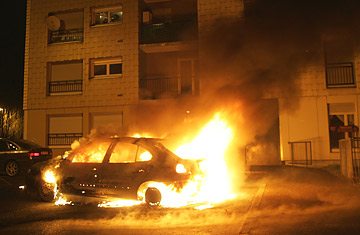
Flames engulf a burning car on New Year's Eve in the suburbs of Strasbourg, France
For much of the world, they became iconic of France's worst social ills: the burned-out carcasses of thousands of cars set ablaze during nearly three weeks of nationwide rioting in 2005. But as yet another orgy of automobile arson on Wednesday demonstrated, the torching of cars in France has not only become an everyday event; it's also now a regular form of expression for disenfranchised suburban youths wanting to make sure the rest of the country doesn't forget they exist. And their fiery presence is never felt so strongly as it is each New Year's Eve — the day of France's unofficial festival of car-burning. (Read a special report on the 2005 French riots.)
According to figures from the French Interior Ministry, 1,147 cars went up in smoke on New Year's Eve — a 30% rise on the 879 autos torched the same night in 2007. As often is the case, the worst-hit areas were the disadvantaged neighborhoods that sit beyond the suburban peripheries of most French cities. A total of 422 cars were burned in Paris-area housing projects, compared to 12 in the relatively well-policed Parisian intra muros. Other cities whose unemployment-racked, racially tense banlieues also lived up to their reputations for frequent car-burning included Strasbourg, Lille, Toulouse and Nantes. Across France, police arrested a total of 288 people on New Year's Eve (vs. 259 the year before) — though not all were charged, and many were apprehended for offenses unrelated to arson. (Read TIME's top 10 crime stories of 2008.)
In a country where car-burning isn't a common symptom of socioeconomic unrest, news of so many automobiles being torched would be alarming — if not a sign of brewing insurrection. In France, however, word of the destruction that accompanied the evening the French call Saint-Sylvestre was met with a mix of Gaulic shrugs and low-grade peevishness.
In revealing the figures on Thursday, French Interior Minister Michèle Alliot-Marie acknowledged that the tally of car-burnings had indeed increased over the previous year. Yet Alliot-Marie also said the enormous fleet of now carbonized vehicles shouldn't darken a New Year's Eve that was "unanimously considered mostly calm." Alliot-Marie also stressed that — in contrast to recent years — the first night of 2009 saw "no damage to public or private buildings." Perhaps, but that was probably little comfort to the people who were forced to walk or make long commutes on public transport after finding their cars melted down on Jan. 1.
Despite Alliot-Marie's rather upbeat depiction of the destruction, her boss — President Nicolas Sarkozy — endeavored to react in accordance with his hard-line campaign promises to impose law, order and state authority in even the most unruly French neighborhoods. But while he vigorously rallied to the side of the victims, his best suggestion for punishing the perpetrators (who are rarely caught or identified) sounded positively permissive. Rather than threaten the young arsonists with jail time, which his government has proposed for other juvenile crimes, Sarkozy recommended that they be forced to reimburse their victims for the damages — and be barred from earning a driver's license until they do.
Sarkozy's seemingly lax solution to tackling France's car-burning bonanza hardly reflects the gravity and scope of the problem. Nearly 43,000 cars were torched in France over the whole of 2007 — an average of almost 118 per day. Alliot-Marie stressed that the rise in the number of burnt cars on New Year's Eve 2008 came at the end of a year in which the total number of autos set alight in the first 11 months had decreased 15%, compared with the same period in 2007. But while annual figures may fluctuate, they've generally swelled since the late 1970s, when French suburban youths first started burning cars as a way to get the attention of society, the media and politicians.
Later the practice became an ambush tactic to draw law and fire authorities to the scene — where they'd then be attacked by gangs. Now the act works as a manner of daily protest against alienation, discrimination and the indifference of more affluent French society.
But another, less specifically-French, factor may also be behind the spike in car-burning rates. According to the National Observatory on Delinquency, as many as 20% of cars burned each year are suspected insurance fraud. If that trend, too, is on the rise, then New Year's Eve 2009 may be a veritable bonfire in France, as recession-bled car owners see the country's annual arson event as a chance to make some extra money.
